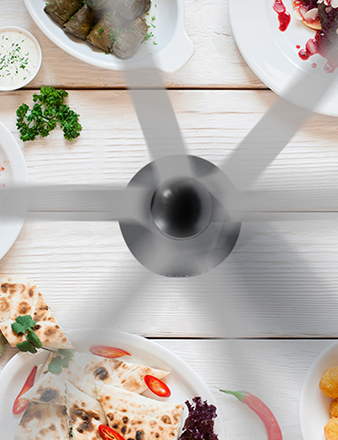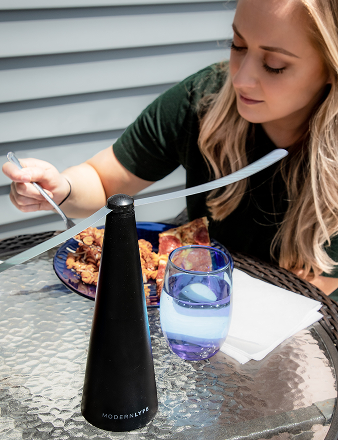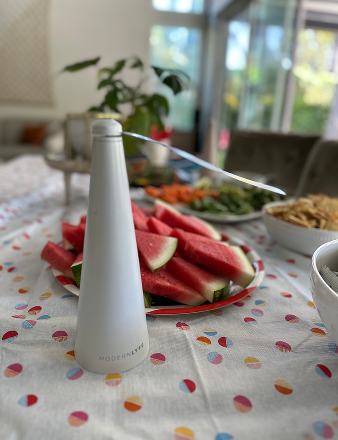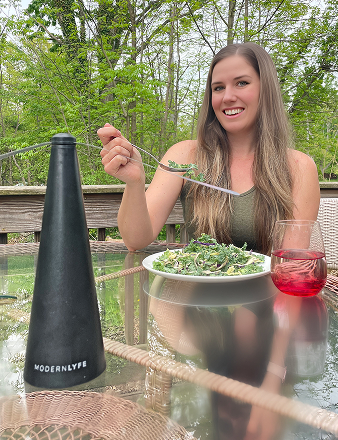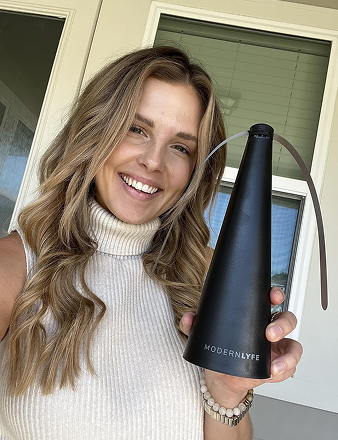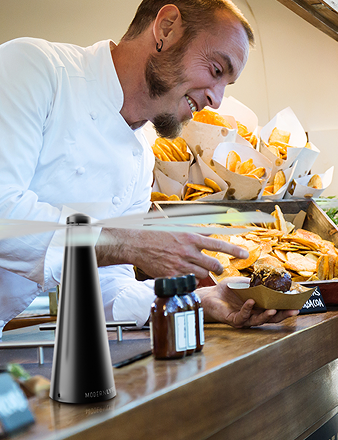Let's be direct: HACCP (Hazard Analysis and Critical Control Points) is about proactive food safety, not reactive damage control. It’s the globally trusted system for preventing problems before they start, protecting your food supply from farm to fork.
What Is HACCP Food Safety
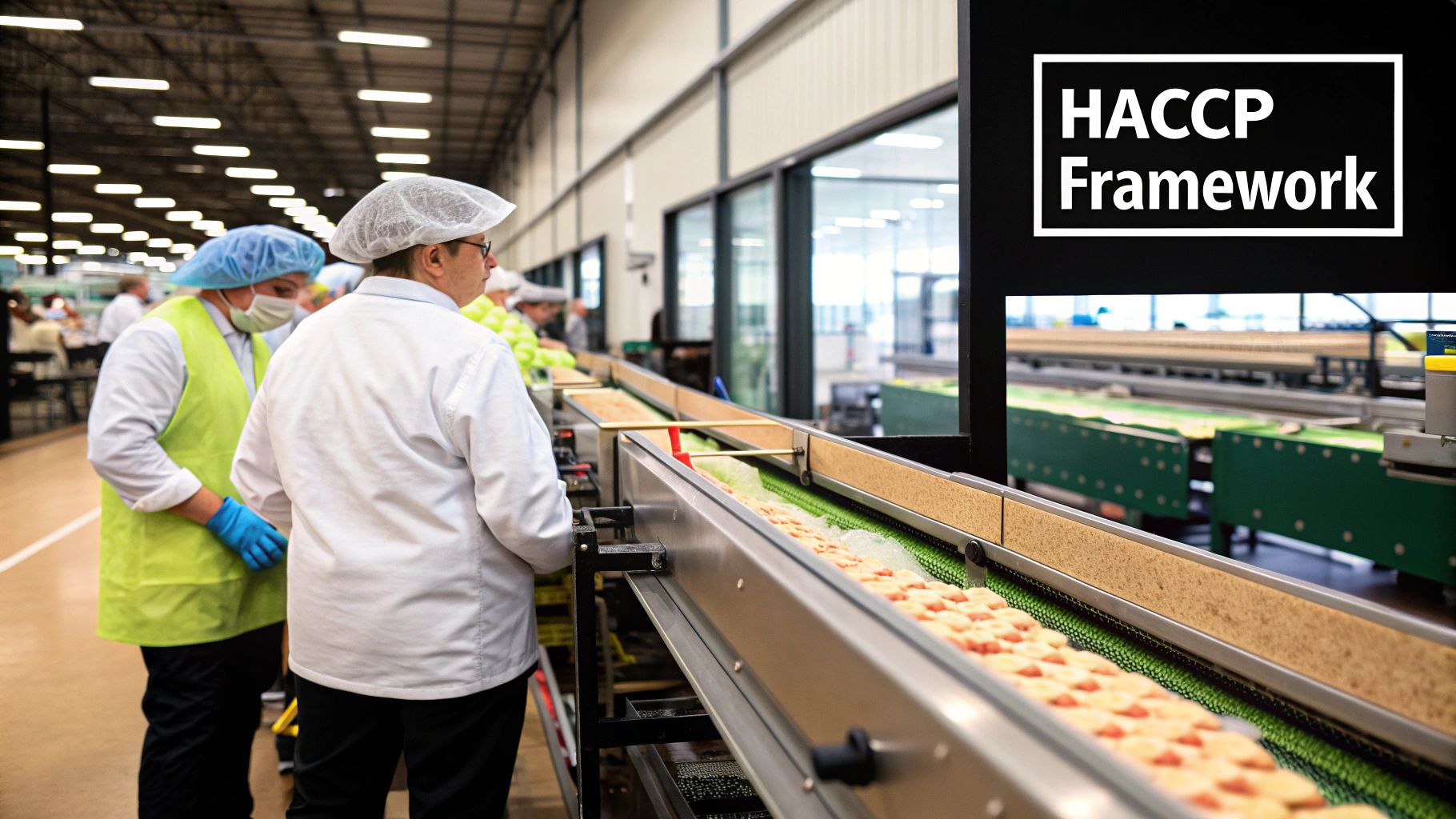
HACCP is a mindset shift. Instead of just inspecting food at the end of the production line and hoping it's safe, you build safety into every step of the process.
This system identifies potential dangers—called hazards—at every stage, from receiving raw ingredients to serving the final dish. By pinpointing these risks upfront, you can implement controls to eliminate them or reduce them to a safe level. It’s a structured plan, not a guessing game.
The core idea behind HACCP is a systematic approach to ensuring food safety by identifying, evaluating, and controlling biological, chemical, and physical hazards.
A HACCP plan is more than a checklist. It forces you to analyze your entire operation and ask critical questions:
- Where could contamination happen?
- Which steps are absolutely essential for ensuring food safety?
- How can we monitor these critical steps to ensure our plan is working?
The Three Types of Food Safety Hazards in HACCP
A solid HACCP plan starts with understanding the enemy. The system classifies potential food safety dangers into three clear categories. Knowing them is the first step toward building an effective strategy.
Each hazard type represents a different way food can become contaminated. The goal is to analyze your processes and identify where these hazards are most likely to appear. For example, the risk of a biological hazard like Salmonella is much higher when handling raw chicken than a physical hazard like a metal shaving.
Here’s a breakdown of the three hazard types your HACCP plan must address.
The Three Types of Food Safety Hazards in HACCP
| Hazard Type | Description | Common Examples |
|---|---|---|
| Biological | Contamination from living organisms like bacteria, viruses, fungi, and parasites. | Salmonella in raw chicken, E. coli in undercooked beef, Listeria on deli meats, Hepatitis A from an infected food handler. |
| Chemical | Harmful substances that can contaminate food, including cleaning agents, pesticides, or unlisted allergens. | Cleaning solution sprayed on a prep surface, excessive pesticide residue on fruit, machine lubricants dripping into food. |
| Physical | Any foreign object that shouldn't be in food and could cause injury if consumed. | Shards of glass, metal shavings from equipment, pieces of plastic packaging, rocks, jewelry, or hair. |
Once you can systematically identify where these threats could enter your supply chain, you have the foundation for a strong safety system. This proactive approach protects your customers, your brand's reputation, and your compliance with regulations.
From Space Missions to Your Plate: The Story of HACCP
The story of HACCP begins not in a kitchen, but in space. In the 1960s, NASA faced a high-stakes challenge: how to guarantee 100% safe food for astronauts on long missions.
A single case of food poisoning in space could be catastrophic. The traditional method of testing random samples from a finished batch wasn't good enough. The risk of a contaminated meal reaching an astronaut was too high.
The Problem With End-Product Testing
NASA realized they couldn't just hope food was safe; they needed a system to ensure it. They partnered with the Pillsbury Company and the U.S. Army Laboratories to create a process for producing "zero-defect" food.
Their solution flipped food safety on its head. Instead of catching problems at the end, they developed a system to prevent them from happening in the first place. This was the birth of Hazard Analysis and Critical Control Points (HACCP).
HACCP was a radical idea born from necessity. It's a proactive system designed to build safety into the entire process—from raw ingredients to the final meal—making sure every single item is safe, not just a few lucky samples.
This shift from reaction to prevention was a game-changer. The team meticulously mapped out every step of food production, identified potential hazards, and established robust controls at "critical" points to stop threats before they started.
The journey of this idea, from a niche space-age concept to a global standard, is a fascinating one.
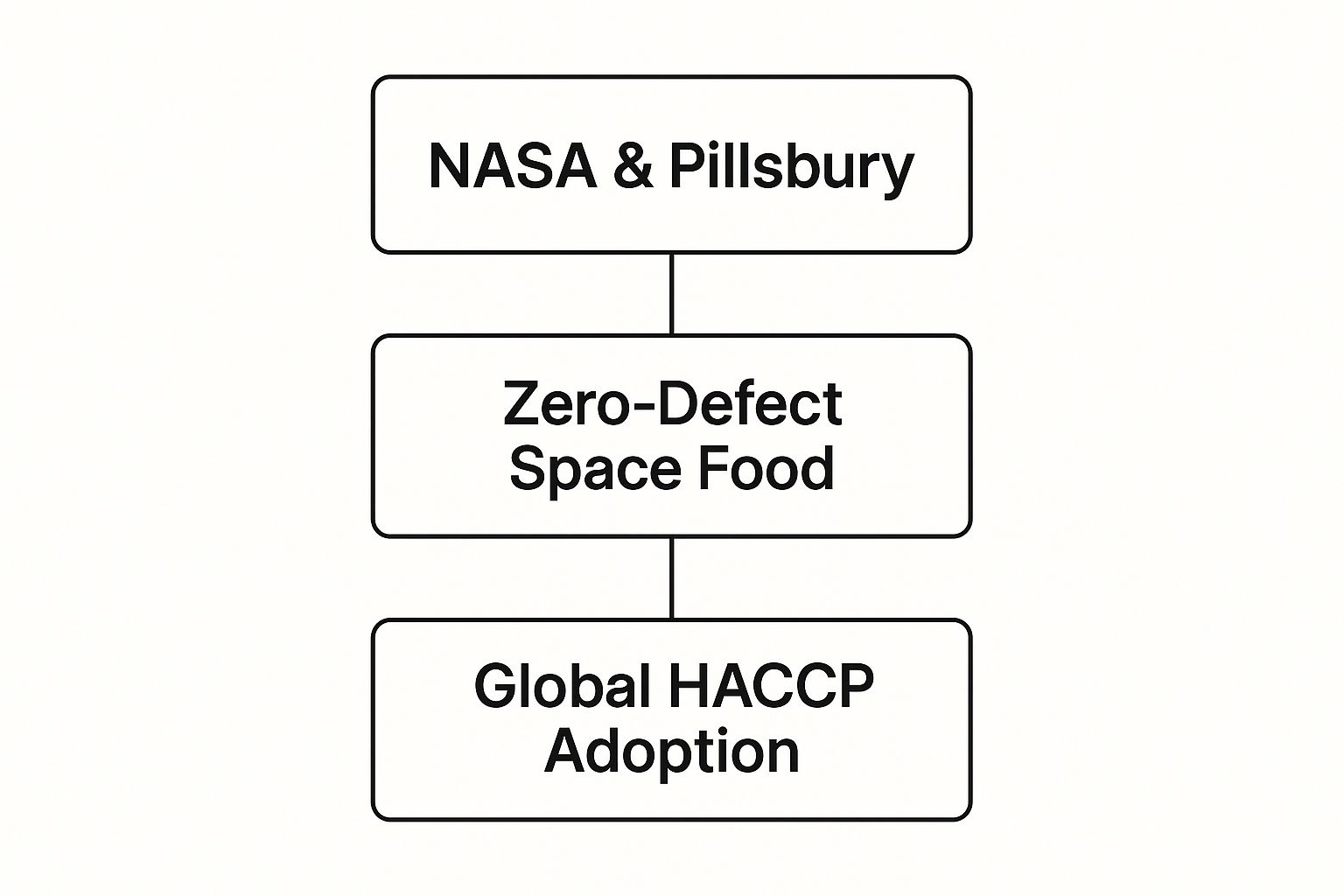
What started as a solution for keeping astronauts safe became the blueprint for protecting dinner plates around the world.
From Space Food to Global Standard
The program's success was undeniable. The HACCP framework was so effective that it quickly became recognized as the most reliable method for producing safe food.
After its success with NASA, the system transitioned from protecting a few astronauts to billions of people. Global health organizations and food regulators saw its potential, and the proactive, science-based approach became the foundation for modern food safety.
The impact has been massive. Countries that mandate HACCP have seen significant drops in foodborne illness outbreaks, with some reporting up to a 50% decrease in cases from pathogens like Salmonella and E. coli. You can explore more data on the impact of HACCP on food safety quality to see how it has reshaped public health.
This history proves HACCP isn't just another checklist. It’s a philosophy of prevention, battle-tested in the most demanding environment imaginable.
Decoding the 7 Principles of HACCP
A HACCP plan is built on seven core principles. These aren't vague guidelines; they are a logical, step-by-step roadmap that turns food safety from a guessing game into a repeatable science.
Think of them as connected building blocks. Each principle relies on the one before it, creating a powerful system for finding, controlling, and monitoring potential dangers before they can cause harm.
Let's walk through each one.
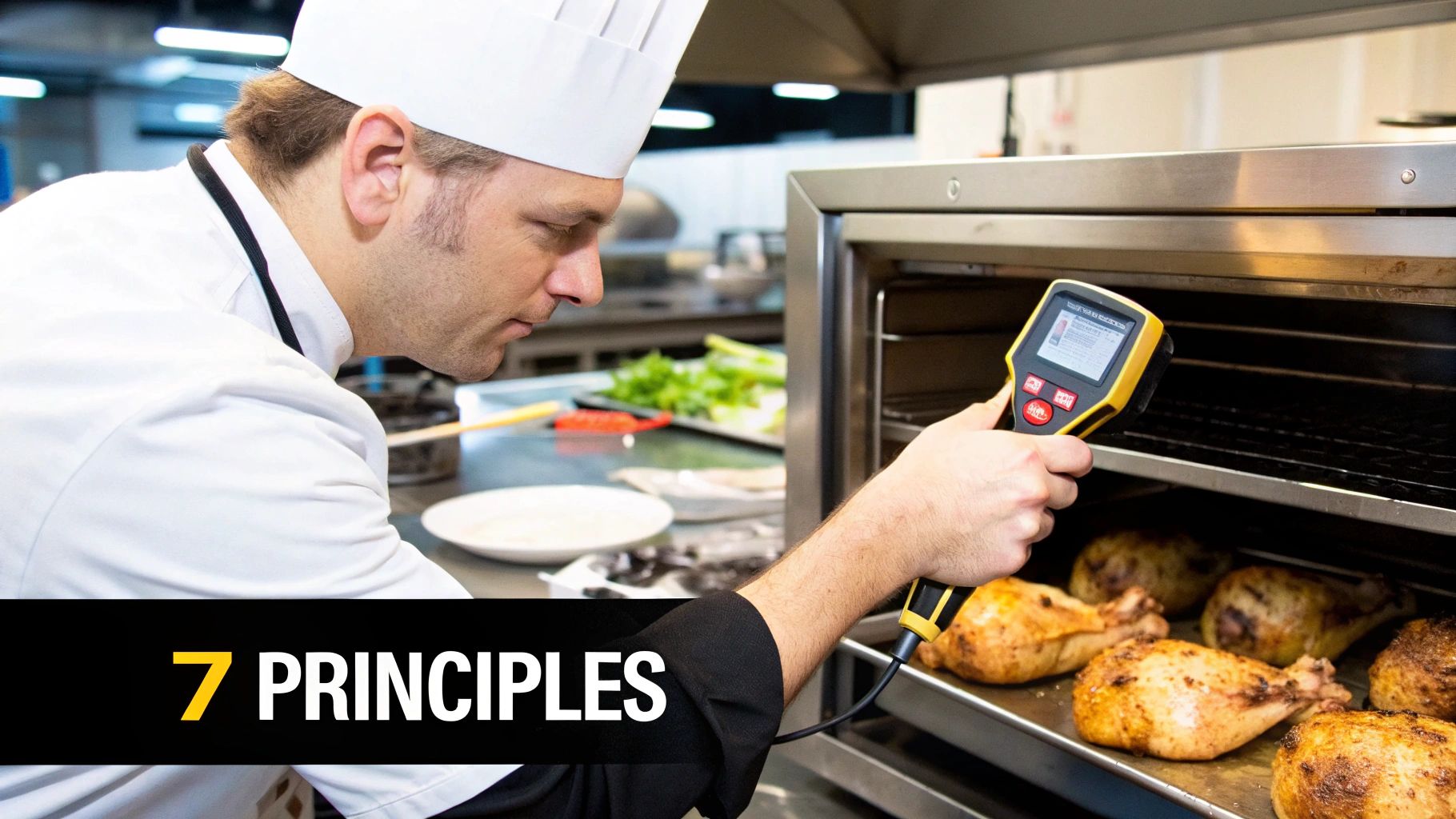
Principle 1: Conduct a Hazard Analysis
First, you need to map out every step in your operation—from receiving raw ingredients to serving the finished product.
At each stage, identify any potential biological, chemical, or physical hazards that could realistically occur. The goal is to pinpoint credible risks tied to your specific products and processes. This analysis is the foundation of your entire plan.
- Real-World Example: A seafood restaurant's hazard analysis for raw oysters would flag the biological risk of Vibrio vulnificus, a bacterium found in warm coastal waters that can cause serious illness.
Principle 2: Identify Critical Control Points (CCPs)
Once you know the hazards, find the exact points in your process where you can control them. These are your Critical Control Points (CCPs).
A CCP is a make-or-break step. It’s a point where, if control is lost, a hazard is likely to reach the customer. Not every step is a CCP—only those essential for ensuring safety.
- Real-World Example: For a chicken processor, the cooking phase is a CCP. If the chicken isn't heated to the correct temperature at this stage, pathogens like Salmonella could survive.
Principle 3: Establish Critical Limits
For each CCP, set clear, non-negotiable boundaries that separate safe from unsafe. These are your critical limits. Think of them as bright-line rules backed by science.
These limits must be specific and measurable. Vague goals like "cook thoroughly" are not enough. You need hard numbers, like a specific temperature, time, or pH level.
- Real-World Example: The chicken plant sets its critical limit for the cooking CCP: every piece must reach a minimum internal temperature of 165°F (74°C) for 15 seconds. Anything less is a failure.
Principle 4: Establish Monitoring Procedures
You can't control what you don't monitor. This principle involves setting up a system to consistently check each CCP and ensure your critical limits are met every time.
Good monitoring confirms your process is on track. The procedure must be clear: who checks, what they measure, how they do it, and how often.
- Real-World Example: The plant assigns a trained line cook to check the internal temperature of chicken breasts from every batch with a calibrated thermometer. This check is performed and logged every 30 minutes.
A HACCP system is a living framework, not a static document. Continuous monitoring and verification are what keep the system effective and responsive to changes in your operation.
Principle 5: Establish Corrective Actions
Even with the best plans, things can go wrong. When monitoring shows a critical limit was missed, you need a pre-determined game plan.
These corrective actions should define what to do with the affected product (e.g., recook, discard) and how to fix the root cause to prevent it from happening again. A solid grasp of how to prevent food contamination is crucial here.
- Real-World Example: If the cook logs a chicken temperature of 155°F, the corrective action is immediate: the entire batch is recooked. The next step is to have the oven's thermostat inspected for malfunction.
Principle 6: Establish Verification Procedures
This step is about confirming your whole system is working as intended. Verification means running checks to validate that your plan is effective, not just being followed.
This "trust but verify" approach includes reviewing monitoring logs, calibrating equipment like thermometers, or sending product samples to a third-party lab for testing.
- Real-World Example: Every Friday, a bakery manager reviews the week's temperature logs. Quarterly, they send a batch of cream-filled pastries to an independent lab to test for bacteria, verifying that their safety plan is working.
Principle 7: Establish Record-Keeping Procedures
If it’s not documented, it didn’t happen. The final principle is about recording everything. Effective record-keeping is your proof that the HACCP system is operating correctly.
This documentation includes your hazard analysis, CCPs, monitoring logs, corrective actions, and verification reports. These records are essential for audits and provide valuable data for process improvement.
- Real-World Example: A large food manufacturer uses a digital system to log all CCP monitoring data, deviations, and corrective actions in real time. Each entry is time-stamped and linked to a specific product batch, making it easy to pull complete records for an auditor.
To make it easier to remember how these pieces fit together, here is a quick overview of the seven principles and their purpose.
The 7 HACCP Principles at a Glance
| Principle | Core Goal |
|---|---|
| 1. Conduct a Hazard Analysis | Find and list all potential food safety hazards in your process. |
| 2. Identify Critical Control Points | Pinpoint the essential steps where you can control a hazard. |
| 3. Establish Critical Limits | Set specific, measurable safety boundaries for each control point. |
| 4. Establish Monitoring Procedures | Create a system to consistently check that your critical limits are being met. |
| 5. Establish Corrective Actions | Predetermine the steps to take when a critical limit is missed. |
| 6. Establish Verification Procedures | Confirm that your overall HACCP system is working effectively as planned. |
| 7. Establish Record-Keeping Procedures | Document all activities to prove your system is working and for traceability. |
Together, these seven principles create a robust, preventative approach to food safety, moving beyond simple reaction to active, systematic protection.
Putting Your HACCP Plan Into Action
Knowing the seven principles is one thing; building a plan that works for your operation is another. Moving from theory to practice is about creating a custom defense system tailored to your specific business.
Every ingredient, piece of equipment, and process step has unique risks. A good HACCP plan is designed to anticipate and manage this complexity from the ground up.
The setup phase is just as important as the principles themselves. Getting these initial steps right ensures your hazard analysis is accurate and your control points are effective.
The Five Preliminary Steps
Before applying the seven principles, you must lay a solid foundation. These five initial tasks provide the context your plan needs to be effective. Rushing this stage can undermine your entire food safety system.
- Assemble Your HACCP Team: You can't do this alone. Bring together a team with deep knowledge of your operation—people from production, sanitation, quality assurance, and engineering.
- Describe the Food and Its Distribution: Be specific. Detail the product, its ingredients, and how it's made, packaged, and shipped. Will it be refrigerated, frozen, or shelf-stable?
- Identify the Intended Use and Consumers: Who will eat this food? The general public, or a high-risk group like children or the elderly? Is it ready-to-eat, or does it require cooking?
- Develop a Flow Diagram: Map out your entire process from start to finish. Create a detailed visual chart of every step, from receiving raw materials to shipping the finished product.
- Verify the Flow Diagram On-Site: Take the diagram and walk the floor. Your team must physically confirm that what’s on paper matches reality. If not, make corrections.
A HACCP plan is a living document, not a static file locked away in a cabinet. It requires continuous attention, review, and adaptation to remain a truly effective shield against food safety threats.
Once you’ve completed these foundational steps, your team is ready to apply the seven principles with precision.
Applying the Principles in Practice
With your groundwork complete, you can now move systematically through the seven principles. Your detailed flow diagram becomes the roadmap for your hazard analysis (Principle 1), helping you spot every potential risk.
From there, you'll identify which hazards require a Critical Control Point (CCP) to manage them (Principle 2). For each CCP, you’ll establish clear, science-based critical limits—like a minimum cooking temperature or a maximum cooling time (Principle 3).
This structured approach is being adopted by businesses of all sizes. A global study on food safety systems showed that the use of international standards like HACCP has jumped from 16.7% to 63.9% in developed countries and from 26.6% to 48.1% in developing regions after implementation.
Creating a System for Monitoring and Verification
The next phase is about bringing your plan to life. This means setting up clear monitoring procedures for each CCP (Principle 4). For example, an employee might be assigned to check and log refrigerator temperatures every two hours.
Equally important are your pre-planned corrective actions (Principle 5). What happens if that fridge is too warm? The plan should trigger an immediate response, like moving the food and calling maintenance. The goal is to ensure no unsafe product reaches a customer. Our guide on essential food safety restaurant guidelines can help you add structure to this process.
Finally, your plan needs verification and documentation (Principles 6 and 7). Verification asks, "Is our plan actually working?" This might involve weekly thermometer calibrations or reviewing monitoring logs to spot trends. Using detailed audit and compliance checklists for food and beverage is a great way to verify your system's effectiveness.
Meticulous record-keeping is the proof—it shows your system is working, protecting both your customers and your business.
Why Adopting HACCP Is Smart Business
It's easy to see HACCP as just another regulatory hurdle. But that view misses the point. Implementing a solid HACCP plan is one of the smartest moves any food business can make, with direct benefits for your brand, efficiency, and growth.
Think of it as an investment in your brand's reputation. In an age where a single food safety incident can go viral in hours, a proactive system like HACCP is your best defense. It shows customers you are serious about their well-being, which is the foundation of trust.

Strengthen Your Brand and Build Customer Loyalty
Your reputation is everything. A certified HACCP system sends a clear message to your customers: their safety is your top priority. That kind of trust is priceless.
When people feel safe eating your food, they become loyal customers who leave positive reviews and recommend you to others. It sets you apart from competitors who may only meet the minimum requirements.
A well-implemented HACCP system transforms food safety from a potential liability into a tangible marketing asset. It’s proof of quality that customers can rely on, solidifying their trust and enhancing brand perception.
Improve Efficiency and Reduce Costly Waste
Beyond brand protection, HACCP offers operational benefits that impact your bottom line. By systematically analyzing every step of your process, you naturally find ways to work smarter and eliminate waste.
This proactive approach helps you spot potential problems before they become costly disasters, reducing product loss. A product recall can be financially devastating, but HACCP helps mitigate that risk.
The system also leads to better resource management:
- Reduced Spoilage: Tight controls on critical points like temperature and storage mean less spoilage.
- Smarter Processes: Mapping your workflow for a HACCP plan often reveals opportunities to streamline operations, saving time and labor.
- Fewer Mistakes: Clear, monitored procedures dramatically reduce the odds of costly errors.
Unlock New Business Opportunities
In today's global marketplace, a certified HACCP plan can be a golden ticket. Many large retailers, distributors, and even entire countries refuse to work with suppliers who lack a verified food safety system.
Implementing HACCP opens doors to new markets and growth opportunities. It makes you eligible for contracts that would otherwise be out of reach, giving you a major competitive advantage. Failing to adopt it means risking being left behind as industry standards continue to rise. Staying on top of common issues is crucial; you can learn more about how to avoid common restaurant health code violations in our detailed guide.
How Technology Is Upgrading HACCP Systems
For years, HACCP relied on clipboards and binders. Today, digital tools are transforming food safety management, making the system smarter and more efficient.
Instead of relying on manual checks, modern systems provide a constant stream of reliable data. This allows operators to spot potential problems in seconds, not hours, and shift from a reactive mode to a truly proactive safety culture.
The Rise of Digital HACCP Management
Digital tools offer a level of accuracy and efficiency that paper can't match. These systems give operators precise control over every step of the process.
Consider these practical applications:
- Automated Temperature Monitoring: Wireless sensors in your coolers track temperatures 24/7 and send instant alerts to your phone if a unit fails. This real-world tool prevents product loss and ensures critical control points are always met.
- Digital Checklists and Record-Keeping: Staff can use a tablet to complete checklists, with every entry automatically time-stamped and stored securely in the cloud. When an inspector arrives, audit prep is just a few clicks away.
This isn't a niche trend. The global Food Safety HACCP software market was valued at around USD 1.2 billion in 2024 and is projected to reach USD 3.5 billion by 2033. This growth is driven by the over 60% of food businesses now using automated systems for monitoring and compliance. You can learn more about the growth of the food safety software market and see the data for yourself.
"The Traqfood application installs connected sensors in restaurant refrigerators in order to automatically carry out all daily temperature readings. The restaurateur can thus be alerted in the event of an anomaly...which prevents him from losing his goods."
The Future of Food Safety Tech
Today's tools are powerful, but the future holds even more promise. The next wave of technology will make HACCP systems more predictive and transparent, moving beyond monitoring to intelligent prevention.
Two areas are set to revolutionize the field:
- Artificial Intelligence (AI): AI algorithms can analyze production data to spot subtle patterns that signal a potential hazard. It could then suggest corrective actions before a safety limit is breached.
- Blockchain Technology: Blockchain offers a transparent, unchangeable record of an ingredient's journey. This technology provides incredible traceability, making it possible to track a head of lettuce from the field to the plate with total confidence.
These advancements are making HACCP more effective and integrated into daily operations, giving businesses the tools to manage food safety with unprecedented precision.
Your HACCP Questions Answered
Even with a solid plan, questions arise when implementing a system like HACCP. Here are answers to some of the most common ones.
Is HACCP Legally Required for My Business?
It depends on your industry and location.
In the United States, HACCP is mandatory for certain sectors, including meat and poultry processing (USDA) and seafood and juice (FDA). For many other food businesses, a full HACCP plan isn't explicitly required by law.
However, most health departments base their food codes on HACCP principles. Proving you have a proactive, risk-based approach to safety is the best way to stay compliant and pass inspections.
How Is HACCP Different from Other Safety Systems?
The key difference is the focus.
Think of GMPs (Good Manufacturing Practices) as the foundation—the basic conditions needed for safe food production, like clean facilities and proper handwashing.
HACCP is the specific security system built on that foundation. It’s a systematic and scientific process designed to identify and control specific hazards at critical points.
GMPs create a safe environment. HACCP builds a targeted plan to control hazards within that environment. Broader systems like SQF (Safe Quality Food) often bundle both GMPs and HACCP into one comprehensive certification.
What Are the First Steps to Getting Certified?
Getting HACCP certified can feel overwhelming, but it starts with a few key steps.
- Build Your Team: Assemble a small group of employees who know your operations inside and out.
- Describe Your Product: Detail your food product—its ingredients, preparation, and intended consumers.
- Create a Flow Diagram: Map out every step in your process, from receiving ingredients to shipping the final product.
- Get Training: Ensure your team receives proper HACCP training. Understanding the principles is essential for effective application.
Once these foundational tasks are complete, your team will be ready to conduct the hazard analysis and build out the rest of your HACCP plan.
Protecting your food and guests is crucial, but flies can undermine even the best safety plan. MODERN LYFE offers an elegant and effective solution with our stylish fly fans, designed to keep your dining areas pest-free without noise or chemicals. Discover the perfect fly fan for your business at MODERN LYFE and enhance your guests' experience today.

